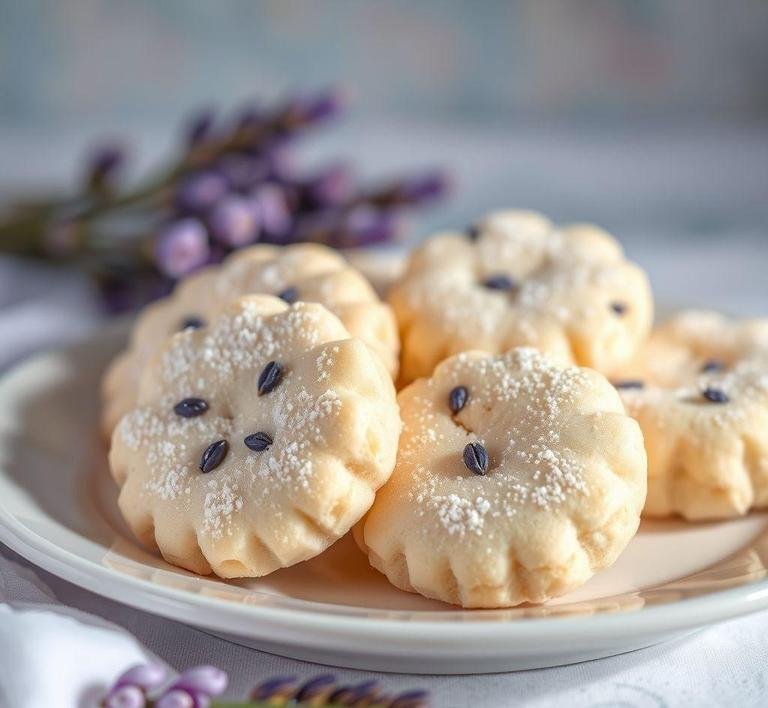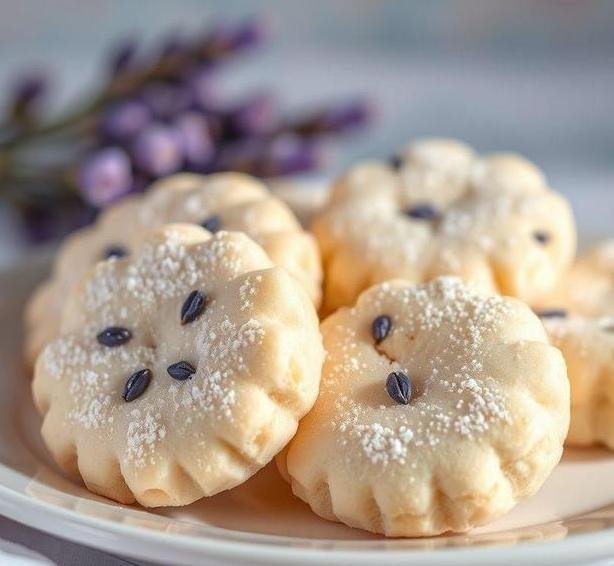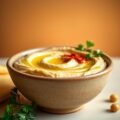Mary Berry’s Lavender Shortbread Biscuits are a sophisticated twist on the classic shortbread, infused with the delicate floral fragrance of lavender. Known for her timeless and approachable baking style, Mary Berry combines the rich, buttery flavor of traditional shortbread with the subtle, aromatic notes of lavender to create a biscuit that is both familiar and unexpectedly refreshing. The lavender adds a hint of elegance to the buttery base, making these biscuits perfect for afternoon tea, special occasions, or as a simple treat to elevate your baking skills.
Shortbread itself has a long history, originating in Scotland, where it was traditionally made with just a few simple ingredients: butter, flour, and sugar. Mary Berry’s version stays true to the essential qualities of shortbread but introduces lavender as an aromatic element, balancing the richness of the butter with a delicate floral touch that enhances the biscuit’s flavor profile.
Lavender has been used in cooking for centuries, particularly in French and Mediterranean cuisines, where its fragrant, floral notes complement both sweet and savory dishes. In Mary Berry’s shortbread recipe, it provides a sophisticated yet understated taste, creating a sensory experience that’s gentle but unforgettable. These biscuits are perfect for anyone looking to try something a little different from the typical shortbread, yet they remain comforting and universally loved for their simplicity.
Mary Berry’s Lavender Shortbread Biscuits Recipe
Ingredients Needed

To bake Mary Berry’s Lavender Shortbread Biscuits, you’ll need the following ingredients:
-
Butter (unsalted) – 225g (about 1 cup)
- The base of any shortbread recipe, butter gives these biscuits their rich, tender texture and deliciously creamy taste. It’s important to use unsalted butter to maintain control over the salt levels in the recipe.
-
Plain flour – 275g (about 2 ¼ cups)
- This forms the structure of the biscuits, giving them their delicate, crumbly texture. Using plain (or all-purpose) flour is essential as it creates the right balance with the butter without making the dough too dense.
-
Caster sugar – 100g (about ½ cup)
- Caster sugar, which is superfine, dissolves quickly and evenly into the dough, giving the biscuits a smooth sweetness. It’s less grainy than regular granulated sugar and contributes to the refined texture of shortbread.
-
Dried lavender buds – 1 tbsp
- The star ingredient of this recipe, dried lavender buds add the unmistakable floral aroma and subtle flavor that defines these biscuits. Make sure to use culinary-grade lavender, as some lavender can be too potent or unsuitable for consumption.
-
Cornflour (cornstarch) – 50g (about ¼ cup)
- Cornflour is used in shortbread recipes to give the biscuits a finer, melt-in-your-mouth texture. It helps to soften the flour and prevent the shortbread from becoming too tough.
-
A pinch of salt – Optional
- While many shortbread recipes don’t call for salt, a small pinch can help enhance the other flavors, especially the sweetness of the sugar and the floral notes of the lavender.
-
Extra Caster Sugar For Sprinkling (optional)
- Some people like to finish their shortbread biscuits with a light sprinkle of caster sugar, which adds a sweet crunch on top and enhances their aesthetic appeal.
Equipment Needed
To successfully make Mary Berry’s Lavender Shortbread Biscuits, you will need the following equipment:
- Baking tray – A flat, sturdy baking tray is essential for evenly baking your biscuits. Lining it with parchment paper or a non-stick baking mat will prevent the shortbread from sticking and ensure easy removal.
- Mixing bowl – A large bowl to mix the dough. You’ll want a space big enough to combine the butter, sugar, flour, and lavender without too much spillage.
- Electric hand mixer or stand mixer – While you can mix the ingredients by hand, using an electric mixer makes the process faster and easier. The mixer helps to beat the butter and sugar until light and fluffy, which is key to achieving a delicate, tender texture.
- Rolling pin – For rolling out the dough, a rolling pin is needed. It helps to flatten the dough evenly and to the desired thickness.
- Cookie cutter or sharp knife – If you prefer to cut your biscuits into specific shapes, use a cookie cutter. You can also simply use a sharp knife to slice the dough into rectangles or squares, depending on your preference.
- Cooling rack – Once the biscuits are baked, they need to cool properly. A cooling rack ensures air circulates around the biscuits, preventing them from becoming soggy.
- Measuring spoons – For accurately measuring the lavender buds and other small ingredients.
Instructions To Make Mary Berry’s Lavender Shortbread Biscuits
-
Preheat the oven:
Start by preheating your oven to 160°C (320°F) if you have a fan oven or 180°C (350°F) for a conventional oven. This ensures that the oven is hot enough when the biscuits go in, allowing them to bake evenly.
-
Prepare the baking tray:
Line your baking tray with parchment paper or a non-stick baking mat. This will ensure that your biscuits don’t stick and will make cleanup much easier.
-
Mix the dry ingredients:
In a bowl, sift together the plain flour, cornflour, and a pinch of salt. Sifting ensures there are no lumps, and the mixture is smooth.
-
Prepare the lavender:
Lightly crush the dried lavender buds between your fingers or with the back of a spoon to release their oils and fragrance. This will enhance the flavor when they are incorporated into the dough.
-
Cream the butter and sugar:
In a separate large mixing bowl, beat the butter and caster sugar together until the mixture is light and fluffy. You can use an electric mixer for this step, or if you’re feeling a bit more traditional, a wooden spoon will do the job. The creaming process is crucial because it creates the light texture of the shortbread.
-
Add lavender and dry ingredients:
Gradually mix in the lavender and then add the sifted dry ingredients to the butter mixture. Mix until just combined. The dough will be quite crumbly at first, but continue working it until it begins to come together into a smooth dough.
-
Roll out the dough:
On a lightly floured surface, roll the dough to about 1cm (½ inch) thick. Be gentle while rolling to maintain the crumbly texture of the shortbread.
-
Cut the biscuits:
Use a cookie cutter to cut the dough into shapes, or slice it into squares or rectangles using a sharp knife. If you’re sprinkling sugar on top, now’s the time to do so.
-
Bake the biscuits:
Place the biscuits onto the prepared baking tray, ensuring they are spaced apart. Bake in the preheated oven for about 10-12 minutes or until the biscuits are pale golden and firm to the touch.
-
Cool the biscuits:
Allow the shortbread to cool on the tray for a few minutes before transferring them to a cooling rack to cool completely. This prevents the biscuits from breaking while they’re still warm.
Tips And Tricks
- Use fresh lavender: If you can, use fresh lavender and dry it yourself. This will give the biscuits an even more aromatic and vibrant flavor. Just make sure to remove any stems before using it.
- Chill the dough: If you find that the dough is too soft to roll out, or if the biscuits are spreading too much while baking, try chilling the dough for 15-20 minutes before rolling it out. This helps the dough firm up and hold its shape better in the oven.
- Customize the flavor: Lavender is just the start of the flavor possibilities. You can try adding other herbs like rosemary or lemon zest to the dough for a different twist.
- Perfect the thickness: The thickness of your dough will determine how crisp or soft your shortbread turns out. For a crumblier, melt-in-your-mouth texture, roll the dough thinner. For a more substantial bite, keep it thicker.
- Don’t overbake: Shortbread is best when it’s just a light golden color. Overbaking can lead to a tough, dry biscuit.
- Storage: Once cooled, store your lavender shortbread biscuits in an airtight container to keep them fresh. They should last for about a week, but they might disappear faster than that!
Mary Berry’s Lavender Shortbread Biscuits are a perfect combination of traditional shortbread goodness with a unique floral twist. The simplicity of the ingredients and process makes it an ideal recipe for bakers of all levels, while the delicate lavender elevates the flavor to a more refined, aromatic experience. These biscuits are a delightful treat for any occasion, whether it’s a special gathering, a cup of tea, or a sweet indulgence on a quiet afternoon.
With a few simple tips and the right ingredients, you’ll soon be making these buttery, fragrant biscuits to impress friends and family alike. If you’re looking for a way to infuse a little extra charm into your baking, these lavender shortbread biscuits should be at the top of your list.
Easy Recipe Variations For Mary Berry’s Lavender Shortbread Biscuits

Mary Berry’s Lavender Shortbread Biscuits are a delightful twist on the classic shortbread, incorporating the aromatic floral notes of lavender. The crisp, buttery texture and the subtle lavender flavor make them a perfect treat for any occasion. While the original recipe is already a crowd-pleaser, there are plenty of ways to customize it and introduce new flavors or textures. Here are some easy variations to elevate or transform these biscuits:
-
Lemon Lavender Shortbread
For a zesty twist, you can add the zest of one lemon to the dough. The fresh citrus flavor will complement the lavender beautifully, balancing the sweet, earthy notes of the shortbread with a lively brightness. Lemon and lavender are a natural pairing, and this combination will create a refreshing and fragrant biscuit that’s perfect for afternoon tea.
-
Chocolate-Dipped Lavender Shortbread
Elevate the indulgence factor by dipping the baked lavender shortbread biscuits in melted dark or milk chocolate. Once dipped, you can place them on parchment paper and allow the chocolate to set. For an added touch, sprinkle a little crushed sea salt or chopped nuts, such as pistachios, onto the chocolate before it hardens. The rich chocolate contrasts perfectly with the light, floral lavender flavor.
-
Lavender & Honey Shortbread
To introduce a touch of natural sweetness, try incorporating honey into the dough. Swap out some of the sugar for honey or drizzle a little honey over the biscuits once they’ve baked. The honey adds a gentle, floral sweetness that pairs exceptionally well with the lavender, enhancing the biscuit’s depth and making it a comforting, rustic treat.
-
Herb-Infused Lavender Shortbread
For a more savory twist, you can infuse your shortbread with a blend of fresh herbs alongside the lavender. Rosemary and thyme are excellent choices, as their earthy, aromatic flavors complement the lavender without overpowering it. A sprig of finely chopped rosemary or thyme can be added directly to the dough for a sophisticated savory biscuit, perfect for pairing with cheese or charcuterie.
-
Lavender Almond Shortbread
Ground almonds or almond flour can be added to the dough to give the biscuits a nutty, rich flavor and a slightly different texture. The nuttiness from the almonds beautifully complements the delicate lavender, while also adding moisture to the dough, making these biscuits slightly more tender. You can also top the biscuits with flaked almonds for extra crunch.
-
Vegan Lavender Shortbread
For those following a plant-based diet, Mary Berry’s lavender shortbread can be adapted to suit vegan preferences. Simply substitute the butter with a dairy-free alternative, such as coconut oil or a plant-based margarine. To replace the egg, use a flaxseed egg or chia seed egg (mix 1 tablespoon of ground flaxseeds or chia seeds with 3 tablespoons of water and let it sit until it forms a gel-like consistency). These adjustments maintain the richness and texture of the shortbread while keeping it entirely vegan.
These simple variations allow you to adapt the basic recipe to suit different tastes and dietary preferences. Whether you want to add a burst of citrus, enhance it with a chocolatey coating, or go for a more savory option, these tweaks give you plenty of room for creativity.
Storing Leftovers
Once you’ve baked a batch of Mary Berry’s Lavender Shortbread Biscuits, you’ll want to ensure they stay fresh and retain their delicious flavor. Shortbread is known for its long shelf life, but proper storage is key to preserving that signature melt-in-your-mouth texture.
-
Airtight Containers
To keep the biscuits fresh, store them in an airtight container. The best option is a metal tin or a glass jar with a tight-sealing lid. This prevents air from getting in and making the biscuits stale. It’s crucial to make sure the biscuits are completely cool before storing them to avoid condensation inside the container, which can make the biscuits soggy.
-
Layering With Parchment Paper
If you have a lot of biscuits, or if they are different sizes, it’s helpful to layer them with parchment paper between each layer. This prevents them from sticking together and maintains their crisp texture. It also helps to separate the biscuits into batches-if you want to preserve a specific flavor or style, like the chocolate-dipped ones or the almond variation.
-
Freezing For Longer Storage
If you want to extend the shelf life of your lavender shortbread biscuits, you can freeze them. Arrange the biscuits in a single layer on a baking sheet and freeze them for a few hours. Once frozen solid, transfer the biscuits to an airtight container or freezer bag, and they can be stored in the freezer for up to 3 months. To thaw, simply let them come to room temperature on a plate or countertop, and they’ll taste as fresh as the day they were baked.
-
Avoid Storing In Warm Or Humid Areas
It’s important to store the biscuits in a cool, dry place. Avoid placing them near sources of heat or humidity, as this can affect their texture and flavor. A cupboard away from direct sunlight is ideal. Humidity, in particular, can cause the biscuits to soften, so keeping them sealed tightly and away from moisture is essential.
Shortbread, especially lavender shortbread, is a treat that tends to keep its appeal for several days (or even weeks) when stored correctly. However, its freshness and delicate texture are always best enjoyed within a few days of baking.
What To Eat With Mary Berry’s Lavender Shortbread Biscuits?
Mary Berry’s Lavender Shortbread Biscuits are a versatile treat that pairs wonderfully with many different foods and beverages. Whether you’re having a cozy afternoon tea or a light snack, these biscuits can be served with a variety of accompaniments to complement their delicate flavor.
-
Tea
Of course, the classic pairing with shortbread biscuits is a hot cup of tea. The floral notes of lavender complement the subtlety of traditional black tea varieties like Earl Grey or English Breakfast. If you prefer something lighter, a delicate white tea or a fragrant green tea would also make an excellent match. For an added twist, try a jasmine tea or a chamomile tea, both of which echo the floral essence of the lavender.
-
Fresh Fruit
Fresh fruit is another great way to balance the richness of shortbread. Serve the lavender biscuits with slices of juicy fruits like strawberries, raspberries, or pears. Their sweetness and tartness contrast beautifully with the buttery, floral notes of the shortbread. For a more indulgent option, you could create a fruit salad drizzled with honey and a touch of lemon juice to enhance the natural sweetness of the fruit.
-
Cheese And Crackers
For a more savory approach, lavender shortbread biscuits can be paired with a selection of cheeses. Soft cheeses like goat cheese, brie, or cream cheese work particularly well. The creamy texture of these cheeses complements the crisp shortbread, and the subtle lavender offers an unexpected flavor note that heightens the experience. Add some savory crackers or olives on the side for a more robust flavor combination.
-
Clotted Cream And Jam
If you’re going for a truly decadent afternoon tea experience, serve the lavender shortbread with clotted cream and fruit jam. The richness of the clotted cream paired with the sweetness of raspberry or strawberry jam perfectly contrasts with the delicate shortbread, creating a mouthwatering combination. This pairing is a quintessential part of British tea time and adds an extra layer of indulgence to your lavender biscuits.
-
Dessert Sauces
For those who like their treats a bit more saucy, a drizzle of lemon curd, chocolate sauce, or caramel can elevate the experience of these shortbread biscuits. The smoothness of the curd or sauce will bring out the buttery texture of the biscuits, while adding a hint of tangy or sweet flavor that enhances the lavender.
-
Wine Or Dessert Cocktails
If you’re serving the biscuits for a more adult gathering, try pairing them with a glass of wine. A light, dry white wine like a Sauvignon Blanc or a sparkling wine like Prosecco would be ideal, as the crisp acidity of these wines balances the richness of the shortbread. For a more playful pairing, consider a lavender-infused cocktail or a fruity spritzer, which would harmonize with the lavender notes in the biscuits.
These biscuits are incredibly versatile, making them suitable for any occasion, from a casual afternoon snack to a more refined dessert spread.
Conclusion
Mary Berry’s Lavender Shortbread Biscuits offer a delightful combination of buttery texture and delicate floral aroma that can easily be customized to suit different tastes. With simple variations such as adding lemon, chocolate, or honey, you can create a whole range of flavors while maintaining the essence of the original recipe. Proper storage ensures these biscuits stay fresh and tasty, whether you’re enjoying them for a few days or preserving them for longer. And when it comes to pairing, the options are endless, from a calming cup of tea to a more sophisticated wine or cheese platter. These biscuits are a true celebration of flavor, elegance, and creativity in the kitchen.
FAQs
What Are The Key Ingredients For Mary Berry’s Lavender Shortbread Biscuits?
The key ingredients for Mary Berry’s lavender shortbread biscuits include unsalted butter, caster sugar, plain flour, rice flour (for a crisp texture), and dried lavender flowers. The lavender is essential for the signature floral flavor, so it’s important to use food-grade lavender. You’ll also need a pinch of salt to balance the sweetness.
How Do You Incorporate Lavender Into Mary Berry’s Shortbread Biscuits Recipe?
In Mary Berry’s recipe, the lavender is first finely chopped to release its fragrance and oils. It’s then mixed into the dry ingredients (flour and rice flour) to ensure the lavender is evenly distributed throughout the dough. Some versions suggest lightly crushing the lavender buds before mixing them, while others recommend steeping them in a small amount of sugar to infuse the flavor before adding to the dough.
How Can I Make Sure My Lavender Shortbread Biscuits Turn Out Perfectly Crisp?
To achieve perfectly crisp lavender shortbread biscuits, be sure to handle the dough gently, as overworking it can result in tough biscuits. After rolling out the dough, chill it in the fridge for at least 30 minutes before cutting out shapes. This helps the biscuits hold their shape during baking. Also, baking at a low temperature (around 160°C or 140°C for fan ovens) ensures the biscuits cook slowly, developing a crisp texture without burning.


